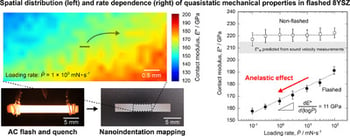PRESS RELEASE
- Research
- 2022
Anelasticity induced by AC flash processing of cubic zirconia
Authors
Hiroshi Masuda, Koji Morita, Tomoharu Tokunaga, Takahisa Yamamoto, Hidehiro Yoshida
Abstract
The defect physics is important for understanding the athermal effect of electric fields and/or currents on the enhanced ionic diffusion during flash sintering of ceramics. In this study, conventionally sintered 8 mol% yttria-stabilized zirconia with a fluorite cubic structure was processed by AC flash and subsequently quenched to partially freeze the flash-induced defect structures. The dynamic and quasi-static mechanical properties of flashed and non-flashed samples were evaluated by a sound velocity measurement and a nanoindentation technique to characterize the mechanical responses attributed to the flash-induced defects. A negligible change was confirmed in the dynamic elastic constants even after flash, while the quasi-static elastic properties of the flashed sample exhibited a considerable rate dependence (i.e., the slower the loading rate, the lower the measured contact modulus). The contact modulus of the flashed sample tested at the slowest loading rate in this study was reduced to approximately 72% of the non-flashed one, where the contact modulus was rate-independent. The time-dependent mechanical behavior was also confirmed during nanoindentation creep. Such rate- and time-dependent mechanical properties are characterized as anelasticity (i.e., viscoelasticity or pseudoelasticity in other terms), which can be attributed to stress-induced and thermally activated recoverable motions of point defects. The flash process of cubic zirconia possibly induced point defects associated with short-range structural change, which could be the origin of anelasticity.
URL : https://doi.org/10.1016/j.actamat.2022.117704

